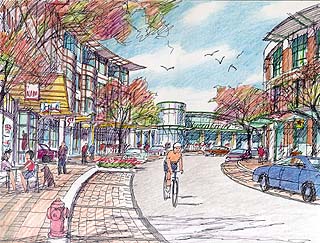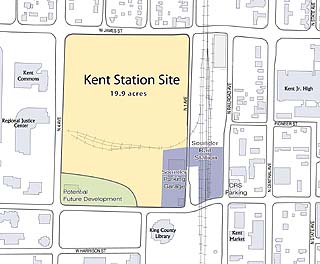
DJC.COM
September 26, 2002
All aboard for Kent’s rebirth
City of Kent

Rendering courtesy of the city of Kent A reworked downtown Kent will be more pedestrian-oriented. |
The Kent Station project is the realization of the city’s vision to create a destination downtown that is the community’s focal point and identity.
Set for groundbreaking in the summer of 2003 and a 2004 opening, Kent Station is a $130 million, 700,000-square-foot mixed-use transit-oriented development project. It will be strategically located adjacent to Sound Transit’s Sounder commuter rail station and parking garage, Kent’s existing downtown and the King County Regional Justice Center.
Kent Station is a public-private collaboration that will be developed by Langly Properties and Tarragon Development on 19.9 acres of property that the city purchased in 2001. With a growing commercial and housing market, Kent has a population of 84,000 residents and is now the largest community in South King County.
The city of Kent has a longstanding vision to create a more vital and identifiable downtown. Both the Kent Comprehensive Plan (1995) and the Downtown Strategic Action Plan (1998) articulate the vision for an expanded downtown with retail, office, residential and entertainment uses located adjacent to transit. Prior to adoption of these plans during the 1980s and early 1990s, downtown Kent experienced the exodus of numerous retailers, including JCPenney.
To further the downtown vision, the city made two strategic investments:
- First, in 1999 the city agreed to contribute $4 million to Sound Transit for the construction of a structured parking facility at the commuter rail station. Four million dollars was the price difference between building a surface parking lot, the original proposal, and a structured parking facility. This investment preserved acres of property that can now be developed at a higher use than a surface parking lot.
Sound Transit commenced commuter rail service in February 2001, helping to connect Kent commuters to downtown Seattle and eventually Tacoma. The parking structure opened in March 2002.
- Second, the city purchased 19.9 contiguous acres of property in the downtown core (adjacent to the Sounder commuter rail station and parking garage) between 1999 and 2001 for $14 million. Purchase of the property enables the city to stimulate and control redevelopment of prime downtown property that was in industrial use.
A majority of this property was in use by the Borden Chemical Plant that at one point had considered expansion as an option. The city partnered with Borden to identify relocation sites and to facilitate its transition off the property.
After purchasing the property, the city, through a competitive process, selected Langly Properties and Tarragon Development, two Puget Sound-based real estate developers, to continue discussions about the future development of the site. A community panel reviewed proposals that were submitted by several developers. In addition, throughout the process, the city hosted a series of open houses to gather public input to shape the vision and details for the project. These open houses have been attended by more than 500 individuals from the area.
In July 2002, the city and the Langly/Tarragon team signed a memorandum of understanding outlining the roles, responsibilities and commitments related to the project and the property.
The Langly/Tarragon team has proposed a $130 million, approximately 700,000-square-foot development that will be anchored by a grocery store, a multiplex cinema, and a branch campus of Green River Community College.
The project will also feature additional retail and restaurants and a publicly-accessible town plaza and water feature. The city and the Langly/Tarragon team are studying the feasibility of one of the theaters within the cineplex doubling as a Kent performing arts facility.

Graphic courtesy of the city of Kent The $130 million Kent Station project is slated for nearly 20 acres near the city’s Sounder commuter rail stop.
|
Langly/Tarragon will purchase the city property in phases, with later phases of the development including office, housing and a hotel.
The Langly/Tarragon team, along with its architect LMN, will apply for a master plan development permit this fall, and it is anticipated the city will issue permits and sign a development agreement before the end of the year. Langly/Tarragon is scheduling groundbreaking for summer 2003.
In addition to purchasing the property, the city committed resources to the project by completing an environmental impact statement and review process for the site. In July 2002, the City Council adopted a “planned action ordinance,” which spells out the environmental mitigation that will be required as part of development of the site.
Finally, the city is investing $4.3 million in infrastructure improvements to the site, including environmental clean-up and construction of an extension of Second Avenue through the site — which will be the pedestrian and vehicle front door of the project. City efforts to build this key piece of infrastructure have been bolstered by two significant grants: $900,000 in federal transportation funds and $900,000 in state economic development funds.
Groundbreaking for the new street occurred Aug. 13, 2002. Second Avenue will be the key connection between the existing pedestrian-oriented downtown and the new Kent Station project.
Kent Station is a once-in-a-lifetime opportunity to grow Kent’s economy and create a mixed-use destination downtown next to mass transit.
Overall, the city is investing $23.5 million into the project, which will become Kent’s new economic anchor and is projected to create over 500 jobs — as well as provide a more vital and identifiable city center with homes, jobs, services and shopping to serve the greater community.
The long-term payback revenues from the project will come from the phased sale of the land to the developer and tax revenues.
Nathan Torgelson is Kent’s economic development manager.
Other Stories:
- Bellevue faces its next stage of evolution
- 10 steps to safer city streets
- Renton rebounds with infill projects
- UrbanSim: Shaping metropolitan futures
- Giving development the old college try
- The urban redevelopment toolbox
- SoDo rezone pits industry against developers
- Lower Queen Anne goes Uptown
- Marketing urban homes in turbulent times
- Joe Average inks blueprints for downtown living
- Understanding history improves future of cities
- Building design — post 9/11
- Monorail elevates transit to a new low
- Condemnation: Whose property is it?
- Building infrastructure for urban vitality
- Urbanization demands better quality housing
- Tax-exempt bonds pump up nonprofit projects
Copyright ©2009 Seattle Daily Journal and DJC.COM.
Comments? Questions? Contact us.